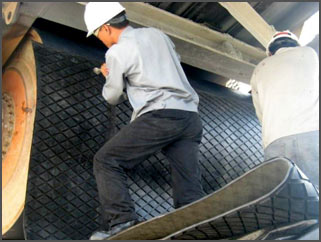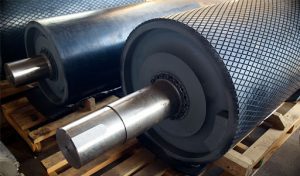Cold Vulcanized Rubber Pulley Lagging

Cold vulcanized rubber pulley lagging is an essential component of conveyor systems that handle abrasive materials or operate in wet or humid environments. It provides increased friction, extends the lifespan of the belt, improves safety, is easy to install, and is cost-effective.
Cold Vulcanized Rubber Pulley Lagging – FRAS

Cold vulcanized rubber pulley lagging – FRAS is an essential component of conveyor systems that operate in hazardous environments where flame retardancy and anti-static properties are required. It provides flame retardancy, anti-static properties, increased friction, extended belt life, improved safety, is easy to install, and is cost-effective.
Hot Vulcanized Rubber Pulley Lagging

Hot vulcanized rubber pulley lagging is an essential component of conveyor systems that operate in harsh environments where durability and resistance to wear and tear are required. It provides increased friction, enhanced durability, resistance to wear and tear, improved safety, easy maintenance, and is cost-effective.
Hot Vulcanized Rubber Pulley Lagging - FRAS

Hot Vulcanized Rubber Pulley Lagging – FRAS is an essential component of conveyor systems that operate in hazardous environments where durability, fire resistance, and anti-static properties are required. It provides increased friction, enhanced durability, resistance to wear and tear, improved safety, easy maintenance, and is cost-effective.
FAQs of Rubber Pulley Lagging
Q: What is a rubber lagging pulley?
A: A rubber lagging pulley is a type of conveyor pulley that has a layer of rubber material applied to its surface. The rubber layer is designed to improve traction and reduce slipping between the pulley and the conveyor belt.
Q: What are the benefits of using a rubber lagging pulley?
A: The use of a rubber lagging pulley can help to improve the efficiency and reliability of conveyor systems by reducing belt slippage, improving traction, and extending the lifespan of the pulley.
Q: What types of conveyor systems can use rubber lagging pulleys?
A: Rubber lagging pulleys can be used in a wide range of conveyor systems, including those used in mining, construction, and other heavy-duty industries.
Q: What are the different types of rubber lagging materials?
A: Rubber lagging materials can vary depending on the specific needs of the conveyor system. Common types of rubber lagging materials include neoprene, nitrile, and natural rubber.
Q: How is a rubber lagging pulley installed?
A: Installing a rubber lagging pulley typically involves removing the old pulley, preparing the surface of the new pulley, and then applying the rubber lagging material using specialized adhesive or vulcanization techniques.
Q: What maintenance is required for rubber lagging pulleys?
A: Regular maintenance of rubber lagging pulleys may include cleaning the surface of the pulley, checking for wear and tear, and making any necessary repairs or replacements to the rubber lagging material.

